Basilica of the Sacred Heart of Jesus
As a relic of the nineteenth century, the Basilica of the Sacred Heart of Jesus is an important architectural icon and the Catholic faith of the time.
The bishop of San Salvador, Antonio Adolfo Perez and Aguilar, considered erect a consecrated to the Sacred Heart Basilica in the capital. It was not until January 1st 1901 the project received a solemn blessing and placed the first stone. The process of construction was approximately two decades, time when a strong earthquake endured 7 June 1917 affecting the central part thereof.
He is considered a capital treasure, for its impressive neo-Gothic design with colorful influences nineteenth century.
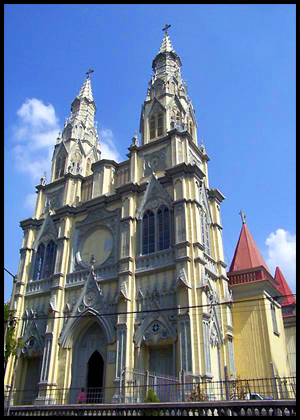
With the passing of the years, elaborate structure of wood and forged blade with a particular technique in Europe, has been preserved despite having endured earthquakes 1917, 1919, 1965, 1986 and year 2001.
It is made with wood construction techniques and foil, very famous in Europe in those years, and have been well preserved inside, so visit is a trip back to San Salvador.
A curious fact is that the dice 1989 to 1999, this temple served as the seat of the Archbishop of El Salvador, belonging to the Metropolitan Cathedral of temporarily, while performing reconstruction in which today is the Cathedral. It developed many activities and liturgies of the archdiocese that still remain.
Chapel of Our Lady of Remedies
For major traditions of Izalco, is devotion to the Virgin of the Remedies, known as the “Venerable town doctor”.
They tell the stories of the elders that since the 1500, Our Lady of Remedies has been subject of veneration by izalqueños. Your guild back to a time of conquest and since its inception has belonged to the core indigenous people. The shrine is said dates from the seventies, and was built for the Virgen de Los Remedios were walking not wandering.
Their celebrations are held from 9 December and is the second most prominent of the people.
You can find more information on the Tourism Promotion Unit of the Municipality of Izalco in Homepage: www.alcaldiaizalco.gob.sv
Church of San Esteban
St. Stephen’s Church is part of the historical heritage of Texistepeque, which dates back to the
eighteenth century and retains period features Colonial.
The interior of the church is of a ship containing ten columns of a single trunk wood with stone bases casi80 cm. height. Inside of the church, the roof is wood and you can see the straps that are what remains of the Mudejar architectural style. On the outside, The facade is Baroque altarpiece type, divided into three sections by encarnizamientos and decorated with half columns and semi vaulted niches.
Church of St. Peter and St. Paul
The church of St. Peter and St. Paul located in the municipality of Caluco, is a relic dating from the sixteenth century and was declared a National Monument by Legislative Decree 576, the 13 September 1990. His early colonial era architecture, is one of the few structures that still exist such, despite the damage it suffered in the year 1773 by the earthquake of Santa Marta and the fire that consumed the 2005.
In El Salvador there are only three churches built in the sixteenth century: the remains of the church of La Asunciónen Izalco, the platform of the church in the Old City and the Temple of San Pedro and San Pablo.
This unique temple façade presented in, a shield with symbolic keys received St. Peter when Jesus promised that on a rock found his church. Likewise, had two semicircular towers located in the northeast and southeast corners, possessing a style that dated back to the Middle Ages. Also, Among notable, architectural style was “Mudéjar” from the south of Andalusia and is characterized by the combination of decorative shapes with Gothic decadent Muslim, the Renaissance and the Baroque.
Cathedral of St Vincent
A 58 kilometers from the capital is San Vicente, a major department paracentral area for its
great historical and architectural value.
Among its most representative buildings of the town center are the historic church El Pilar, the imposing Tower of St. Vincent and the cathedral located at the head of the latter.
This church was built to consecrate as ecclesiastical seat of the department 18 December 1943. The façade design is eclectic with neoclassical influence artistic details.
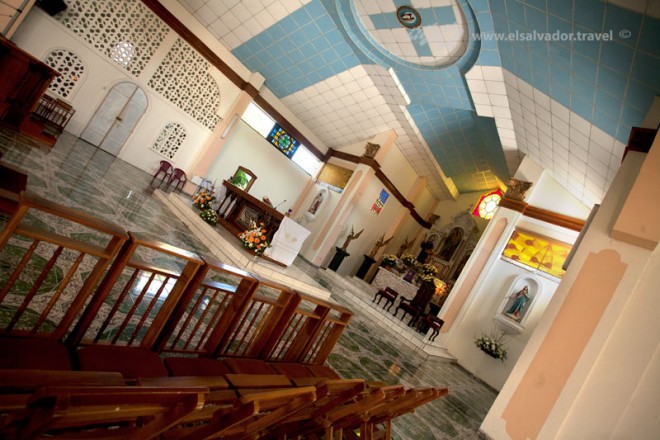
At the main gate appreciate a stunning representation of San Vicente Abad and Martyr in relief and made of bronze.
The original internal ship of the church collapsed after the earthquakes in the year 2001, forcing a total rebuild. The new design emulates architectural elements of the façade. Along the hallway displays a ceramic road leading to the main altar where the imposing marble altarpiece temple adorns this section.
The festivities are held annually the 15 to the 31 December in honor of San Vicente Abad and Martyr. Other holidays are becoming 15 January in honor of the Lord of Esquipulas and 25 October to 3 November in honor of All Saints.
Visit San Vicente and discover the different architectural remains that await you in this amazing region of our country.
Church of Our Lady of Pilar, San Vicente
Historical and invaluable is the impressive church of Our Lady of Pilar, an architectural tesoro de San Vicente.
This building hoards interesting anecdotes that occurred in the eighteenth century, situated across the square Alvaro Osorio Quinonez, founder of this department.
The origins of this sanctuary are due to a peculiar event became a popular anecdote Vincentian.
Jose Merino, devoted to the Virgen del Pilar, was three times besieged by an attack of jealousy of his wife Manuela de Arce who wanted to kill him to death while he slept. Their attempts failed because the religious picture moved every time she tried to kill him until, in the last attempt, Manuela came to his senses.
After this event, Merino wanted to build a chapel in honor of the Virgin in 1762 but died and could not see the entire work. Later his wife continued construction and delegated to Francisco de Quintanilla.
Quintanilla died two years after starting the project and his daughter Michelle was in charge and was completed in 1769, year that blessed day 12 December.
It is said that the temple had very rich gold jewelry and the crown of the Virgin Mary was invaluable.
Years later, San Vicente began to unfold strong indigenous movements. This frightened her wealthy residents and deposited their jewels in this temple believe that this site would be respected.
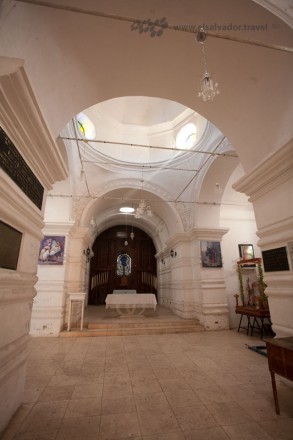
The 15 February 1833 the church was sacked by the Indian Anastasio Aquino and his followers. It is said that his party chopper, altars and images rolled across the floor until Aquino took the crown of the statue of St. Joseph and was proclaimed “King of the Nonualcos”. Later Aquino was imprisoned and executed for their actions.
As for the original architectural details the temple had a clay brickwork and glazing. This material is then replaced by cement brick.
This temple was severely damaged due to earthquakes in the year 2001, so that restoration work was carried out from 2004 a 2008. Also, adjacent to the original chapel was erected a new church for church activities in the area.
During his visit to the church El Pilar see beautiful Baroque details, Die walls dispersed, an impressive wooden altarpiece before the central altar and beautiful pieces of ancient imagery.
In the crypt lie the remains of the Quintanilla family descendants and the prominent hero José Simeon Cañas, buried 4 March 1838, who was known as the liberator of slaves of Central. Also Dr. Antonio José Cañas, whose name the central park of the city and other illustrious guests of San Vicente.
The church was declared a National Monument in February 1953 and is a Cultural Asset Protected by the Hague Convention 1954.
Come and discover these architectural beauties that make up the various national treasures of this stunning corner of San Vicente.
Church of St. Nicholas Bishop of Myra, Resume
A 18 kilometers from the capital, Resume township is a town of rich history and preserves important cultural elements evident in their customs and architecture of old.
Such is the case of the temple erected in honor of Saint Nicholas bishop from Mira that comes from the colonial era.
Resume was a settlement Pipil, after the Spanish conquest, this territory fue founded as St. Nicholas in Tonacatepeque 1560. With the passing of the years it was abandoned and became known as Pueblo Viejo.
It is said that the Franciscan order undertook to teach Catholicism to the Indians and were the ones who built the temple.
In Tonacatepeque tells a legend that employer’s image disappeared from his chapel in a place called San Juan Resume. The Indians were very devoted and searched until they found the foot of a tree, tree sacred to the native, and want to remove it was heavy. With efforts succeeded in removing the piece and pilgrimage with her in hymns and prayers. The story goes that after the days, the same event occurred; reason earnestly Indians decided to place huts on site, raising the su instead, colonial temple of the holy name.
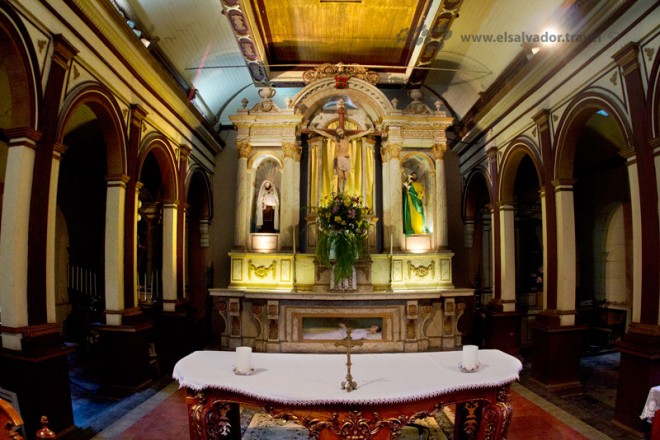
Today Tonacatepeque main church stands out among its streets with a striking facade and imposing.
This construction has managed to survive despite the inclement weather as it retains the structure made of masonry, bahareque, mud and bamboo, style very old and traditional construction.
Inside appreciate wood accents and eclectic accessories with classical and Greek. Also you can view the imagery presented in the altarpieces of relief along its corridors.
The parish is located next to the central park José Maria Villafane. In front stands a statue in honor of the renowned priest Nicolas Aguilar, native Resume, who participated in the independence movements of the eighteenth century.
According to Catholicism, Bishop Saint Nicholas is known as “protector and defender of the people”. In celebrating their festivals Resume 1 to the 6 December each year.
The town also have other co festivities employers, as the martyrdom of San Juan Bautista, since 26 to the 29 August and other patrons of the colonies, neighborhoods and villages that make up this town of San Salvador.
Iglesia El Rosario, San Miguel
The historic city center of San Miguel currently protects architectural remains more than two centuries old.
The central parish “The Rosary”, also known as Santo Domingo Church, no exception.
Located two blocks to the right of cathedral, on 4th Avenue North, is a chapel that became operational in the eighteenth century under the administration of Dominican priests and hor-day keeps the older files of the city.
This was private and only opened its doors to the Marian feasts held every first Sunday of May and October in honor of the Virgen del Rosario.
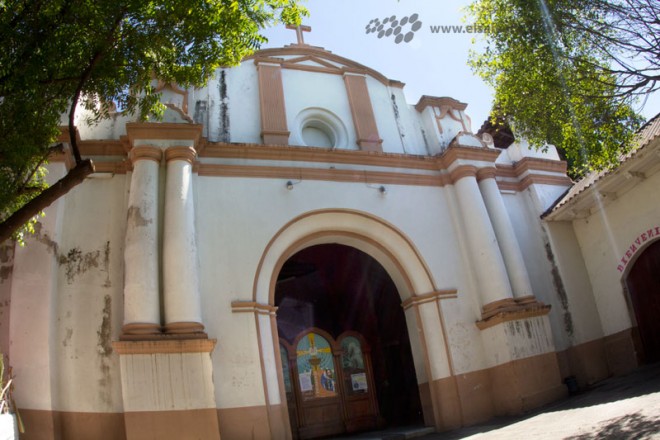
Los architectural details of this temple are of great belleza, beginning with its striking forged wooden doors delicate details.
Impressive appreciated inside old samples scale imagery, some of these offerings from different families in thanksgiving for requests granted. Display wooden columns and wood remarkable concave niche that reads “Sacratissimi Rosarii Regina” in Latin, which enthroned the main image of the Virgin of the Rosary.
Walking through its modest main corridor will appreciate unique ceiling decoration dates back to ancient times of yore.
Torre de San Vicente
Paracentral zone of El Salvador custody impressive architectural monuments of great historical and artistic value. Such is the case of the prominent San Vicente tower erected in the city’s central park.
The mid- 1923, initiative of the Workers’ Ideal Society began building a kiosk at the famous “Plazuela Cañas” for submission of poets, orators and orchestras as the Regimental Band of the V Infantry Brigade for the entertainment of the Vincentians. The park opened to 1924.
Between 1925 and 1926, the locals united efforts with the support of the departmental governor Horacio Villavicencio and endorsement of President Pio Romero Bosque where drawings proposed the idea to beautify the square with an imposing tower and a clock should be placed on its summit.
The plans for the clock and tower were ordered from a German company of the city of Berlin. But the stories feature the designs were destroyed during the Second World War.
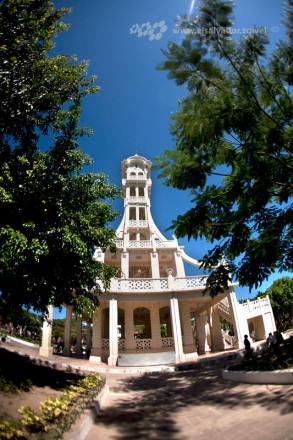
After some economic drawbacks, Romero Bosque facilitated the construction of this monument to perpetuate his memory in the city Vincentian, whose works were implemented until 1 February 1928. It estuvó architectural sketch in charge of Roberto Miranda.
This icon was built by Eugenio Vincentian Grepiat and Luis Esterman, Lucio finished work Capelar engineer in 1930.
Note that the tower withstood the earthquake 1936 but not those that occurred in the year 2001 that left her severely damaged. Later works were carried out to strengthen its infrastructure and has managed to keep up to date.
This great foundation stands between the majestic volcano of San Vicente, better known as “Chichontepec” and the beautiful cathedral opposite the central park.
It has a height of 40 meters and consists of six levels with two entrances that begin with 22 respectively stands. The elevation is seen with greater intensity throughout the 109 spiral stairs leading up to the bell that rings every 15 minutes melodies change every two hours.
Come and discover these architectural beauties that make up the various national treasures of this stunning corner of San Vicente.
Theatre Ruins
This building is the oldest in the city and was one of the first three tile-roofed buildings, the other two were the church and the parsonage, the rest was thatched roof, for it was known as “The House of Tiles”. In this house lived the family and subsequently Orellana Milla Normalde School ubicola Suchitoto which began operating in 1954.
With the conflict deteriorated to the point of being practically in ruins, reconstruyéndose later preserving details like a triple access with arches, with pilasters and modular top, There are also remains of a railing above the cornice and on the south side there is a vestibule with pediment arch.
Today this historic building is the scenario plays, cultural and artistic activities.
National Theatre “Francisco Gavidia”, San Miguel
This historical monument is an architectural vestige of utmost importance for the development of the arts in the department of San Miguel.
In 1901, Development Board of San Miguel created an executive agreement to erect buildings that contribute to the beautification of the city.
In this way the idea of creating a theater in the area. The design and implementation was conducted by Mark Latvian, University graduate Lombaina, Belgium.
Construction began on 1 January 1903 until 31 December 1909. It opened with the play “The Merry Widow” that was presented at twelve midnight.
Between 1914 and 1915 reaches the cinema to theater in San Miguel until 1927 displays were most popular for fans.
From 1936 was awarded the National Theatres circuit control of artistic and made changes in the facilities to address the needs of film and the performing arts.
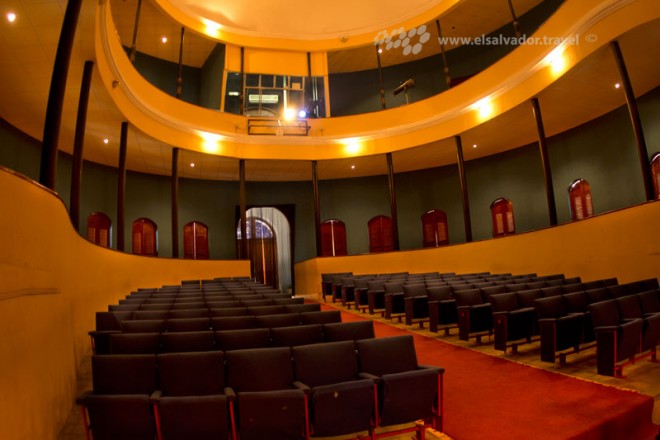
Anecdotally feature the artist Pedro Infante visited the theater to stage a concert in the early fifties.
With the passing of the years, the building was seriously affected to the point of being abandoned by the entity that managed to 1961.
In 1971 a group of students and artists came together to prop up this remnant of San Miguel, as it would be demolished. Four years later, the Ministry of Finance sold the building to the Ministry of Education who, through the Directorate of Cultural Heritage, undertook to restore and revive its aesthetic significance for the cultural development of the country.
It was recorded that in 1988 missed the acoustic stack had the theater in attempts to improve the building.
Note that in 1991 was declared a National Monument by legislative decree 19 November of that year and came under the administration of the National Council for Culture and Art (CONCULTURA) now called Ministry of Culture of the Presidency (SECULTURA).
This government entity restoration work performed from 2001 a 2006. Incorporated backstage, toilets, Instead of lighting and sound equipment provided by the Japanese government who also provided training to staff.
Now you can enjoy the classic architecture. It has 450 comfortable armchairs where you can appreciate the artistic.
The Lobby is a modest and elegant space that will lead to the Hall Foyer, located on the second level. At this point four beautiful terraces appreciate, on the right side, see a fascinating picture of the volcano Chaparrastique.
The National Theatre “Francisco Gavidia” San Miguel has been declared to be a protected Cultural Asset by the Hague Convention 1954.
Archaeological and Ethnographic Museum Nahulingo
The Museum of Archaeology and Ethnography Nahulingo (MAEN), is open to the public since July 2004 to raise awareness of the rich history of this town, whose origins date back to the year 1,200A.C.
This museum houses an exhibition of pieces of stone, clay and ceramics, most of them were protected by local. The museum is divided into five rooms: ethnographic historical room, in which are shown through photographs, objects and documents, Aspects of the municipality as oral tradition, popular religion and customs.
In the living lithic archeology exhibit contains pieces of stone carved with human and animal figures, found in the cantons Grind Stone and The Guava, y en Nahuilingo, dating from the prehispanic, classic pre periods, classic and post classic.
In the ceramic archeology room, display pieces as utensils used for food storage and transport of grains; likewise, musical instruments such as bells and whistles; dio figures of the demigods, winches to twist wire and ceramic figurines associated with fertility rites of religion and.
House of Culture of Puerto de La Libertad
The Puerto dela Libertad, located in the coastal zone dela Freed department only 30 minutes from the capital, offers a variety of activities for the enjoyment of tourists, how to surf, Buenos Aires gastronomy, nature, walks, beach crafts and culture.
A place where you can learn about the history and cultural activities inthe Casadela Puerto ofthe Liberties Culture, located on the main street opposite the Port of La Libertad Malecon.
Your job is to promote and create opportunities for the development of artistic expression, and cultural traditions of the municipality, through activities that have the active participation of children, young and local people. Encouraging further, strengthening creativity and identity, as elements that emphasize the municipality and provide value to their expressions.
Eastern Regional Museum
Founded on 27 May 1994 is a cultural and educational corner that protects critical elements that make up much of the identity of the famous “Pearl of the Orient”.
Located in an old building that was built in 1935 administrative offices where they operated a textile yarn and fabrics called “Social Improvement”. Over the years the building was to be administered by the Battalion of Immediate Reaction Infantry General Manuel José Arce (ONE OF Arce) until the end of the armed conflict in 1992.
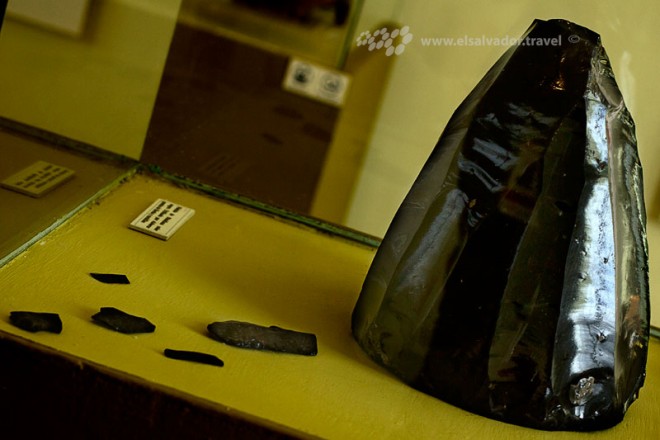
After these social events became the center of government and that nowadays various state agencies work on site.
The infrastructure was severely damaged by earthquakes in 2001 and refurbishment work was carried. Until 14 November 2007 again opened its doors to visitors, showing different exposures, recreational and artistic activities for students and the general.
Museum Form
Located near the monument to El Salvador, Form museum is a unique artistic corner.
This is a space dedicated to the arts and education Salvadoran cultural visitors, which also supports creative artists, mainly younger.
Founded in 1983, by pintora Julia Diaz, who dedicated this initiative to protect with zeal and selflessness Salvadoran plastic creations in order to bequeath to future generations.
Since, The museum is divided into seven rooms displaying approximately 85 parts divided by themes such as realism, surrealism, Abstract Art, portraits, lithographs and more.
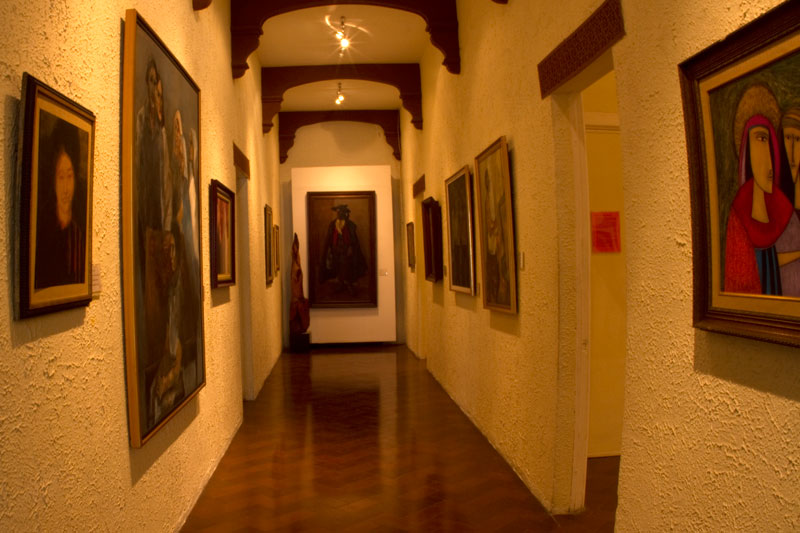
The museum devotes shape like a little oasis of knowledge about the history Salvadoran plastic. All visitors soak up the impressive achieve artistic production created by teachers and students over the years.
Those works are resguardas in a beautiful house built in 1932 by architect Armando Sol and belonged to the family Meardi Pinto. He is considered a jewel of neo-colonial architecture of the capital.
The museum has a library open to the public with a variety of reference books in Spanish, English and French. Also, may bring memories as postcards, crafts, lithographs, books and paintings at prices ranging $0.50 USD a $100.00 USD.
Notably, Julia Díaz Foundation works hard to promote the arts in different sectors of the country, especially focused on children and youth with artistic potential their supporters to achieve educational programs, scholarships, other opportunities.
Visit Museum where you will find an interesting shape artistic side completely Salvadoran and original.
Cuscatlan Park
Cuscatlan Park is one of the most representative historical legacies of the capital, and one of its most important public spaces. It was in March 1939, under the administration of President, Maximiliano Hernandez Martinez, the date you opened this beautiful park. It was named in memory of the “Lordship of Cuscatlan”, they found the Spanish arrival in the territory at the time of discovery.
This site is bordered by two major arteries of the city: the famous Alameda Franklin D. Roosevelt, officially inaugurated in 1945 and Avenue Dr. José Gustavo Guerrero, better known as the “25th Avenue South”.
Formerly, rental service had horses and bicycles, where sales of food and delicacies could not miss, as today. Is said to, despite the time, has managed to maintain the same style of streets and passages with French style lines that are complemented by mature trees and colorful, including pine stand, almond, also known “Madre Cacao” and the colorful “Tree of Fire” that provide shelter for many species of wildlife in the city.
The historic place offers playgrounds at different points. Small sports fields, to practice football and basketball, were added in 1970. Even, this vast terrain has a small amphitheater and rest areas for visitors.
The trails of this recreational space also connected with National Exhibition Hall “Salarrué”, that works a monthly basis Expone Guides niggas artists Salvadorans free.
With the evolution of the city and its events, adding sculptural monuments were personalities of culture and also to honor the national historical memory, after the armed conflict ended in 1992.
Among them we can highlight the recognition Salvadoran Entrepreneur (on October 2010); also a tribute to the Honduran poet Juan Ramón Molina, who left an artistic legacy to El Salvador until his death in 1908, in Ciudad Delgado. Also appreciate a sculpture dedicated to the Nobel Prize for Literature in 1973, the prominent Chilean Pablo Neruda.
One of the most important icons Cuscatlan Park is its mural called “Monument to Memory and Truth” , a space dedicated to the more than 30 thousand victims of massacres, disappearances and human rights violations recorded by different social organizations in the period of the civil war in El Salvador, during 1970 to 1991.
Come and enjoy the architectural vestiges of the mid-twentieth century that still retains our great San Salvador.
